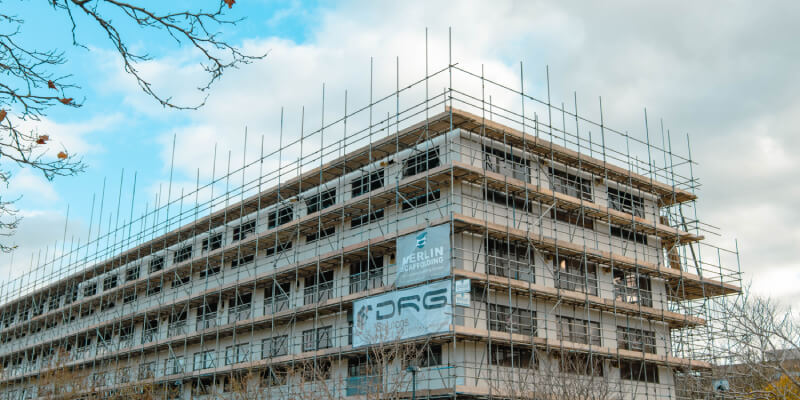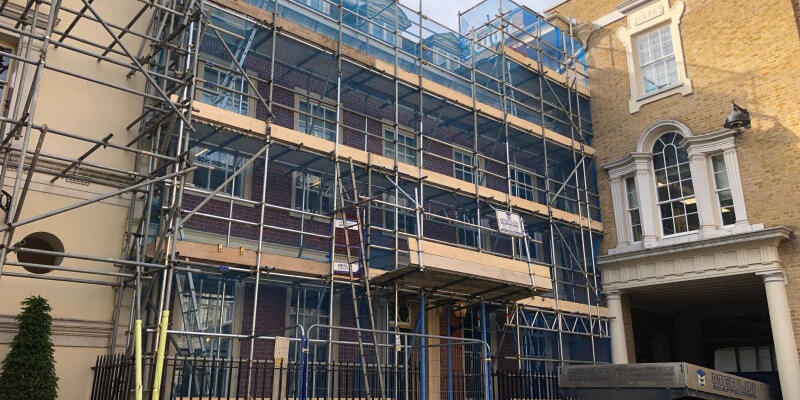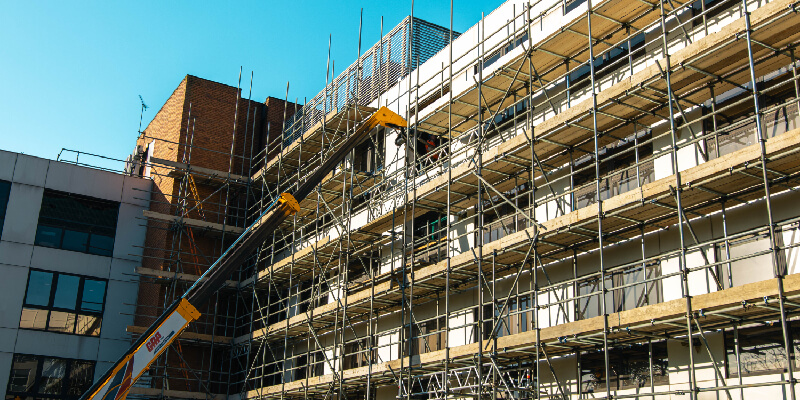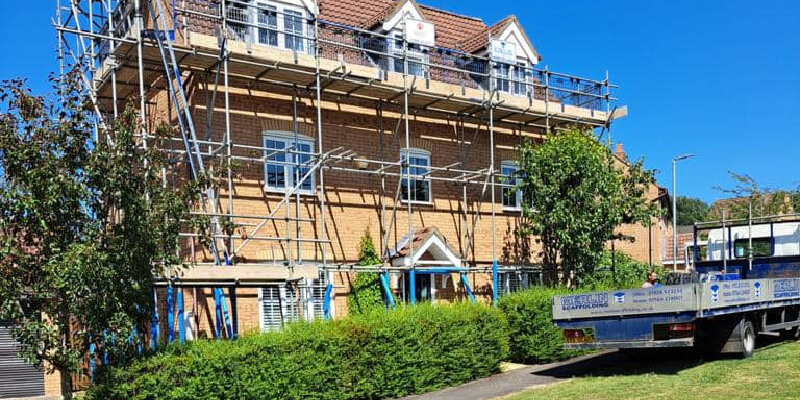To scaffold or not to scaffold, it’s a question as old as time. And with the basic scaffolding regulations constantly shifting, it’s becoming increasingly difficult to know where your project stands. These blurred lines have left many property developers and homeowners scratching their heads. Luckily for you, we’ve been supplying scaffolding in Milton Keynes and surrounding areas for over 20 years, so we know a thing or two about the laws surrounding it. In this article, we’ll walk you through the relevant regulations and help you answer the question: ‘Do I need scaffolding for my project?’
Do I Need Scaffolding? Your Questions Answered
In the UK, falls are the most common cause of workplace death, so it’s no surprise that the relevant authorities are always looking for ways to improve the safety of those working at height. Technological developments and site safety qualifications mean today’s construction workers are safer than ever, but adhering to the latest health and safety regulations remains the best way to protect everyone involved in the project. With that in mind, we’ll be answering your scaffolding questions to ensure you follow the correct procedures.
- What Projects Require Scaffolding?
- Do I Need Permission To Put Up Scaffolding?
- What Scaffolding Safety Requirements Do I Need To Meet?
- How Much Scaffolding Do I Need?
- What Height Scaffolding Tower Do I Need?

What Projects Require Scaffolding?
Despite consistent amendments to the scaffolding regulations, there remains no set definition regarding which projects require scaffolding. This is because it’s impossible to provide a blanket solution for construction projects with varying levels of risk. It’s essential to conduct a risk assessment before any construction project so you can decide which safety equipment is appropriate. Your trader should use their expertise to assess the risk and ensure their staff are safe on your property. If you plan to complete the construction yourself, you’ll be liable for on-site injuries.
A risk assessment will clarify that erecting scaffolding is the safest solution in most construction projects with consistent work at height. However, these are some factors you should take into account before reaching a conclusion:
- Size of the job: For minor jobs, scaffolding might be surplus to requirements and unnecessary. Safely secured ladders can be used for low-risk short work where only one person is needed at height.
- Job timeline: Scaffolding is advised for projects that involve working at height for several days.
- Working conditions: External variables like weather conditions and footfall in the surrounding area are essential considerations when deciding whether scaffolding is needed.
As a general rule of thumb, all elevated construction work on commercial properties will require scaffolding, and most work at heights on residential properties should also use scaffolding. As scaffolding is commonplace, it’s easier to highlight projects that won’t require external framing rather than listing those that will. These kinds of construction include:
- Small-scale repairs and maintenance: Minor repairs, like fixing small cracks or repainting low-level areas, can be completed with ladders.
- Gardening and landscaping: Landscaping projects and constructing ground-level features like patios generally do not require scaffolding.
- Roofing work on bungalows: Roof repairs and installations on single-story structures can be cone with ladders or other safer alternatives to scaffolding.
- Fencing and boundary work: Installing or repairing fences, walls, and other ground-level boundary structures does not require scaffolding.
- Demolition of small structures: Single-storey structures can often be managed without scaffolding.

Do I Need Permission To Put Up Scaffolding?
You won’t need planning permission to erect scaffolding, provided it is entirely within the boundaries of your property. You can get an idea of where the boundaries for your property are by looking at its title plan. If any part of the scaffolding extends outside your property’s boundaries, whoever is in charge must get a license from your local council. While this may seem daunting at first, there are online systems to help streamline the application process. You can use this GOV.UK tool to better understand the requirements and fees associated with your local council’s application process.
Extra permissions may be required if you plan to complete construction work on a listed building or a property in a conservation area. This may include listed building consent or planning permission intended to protect historic or architecturally significant structures. Additionally, you may need to coordinate with utility companies if your scaffolding will interfere with infrastructure like overhead cables and pipes.
If you’re unsure about the specific requirements of your project, it’s best to consult with scaffolding specialists like Merlin Scaffolding. We’ve been a leading scaffolding company in Milton Keynes for over 20 years and would be more than happy to help guide you through the complex world of scaffolding.

What Scaffolding Safety Requirements Do I Need To Meet?
The scaffolding safety regulations are outlined by the National Access and Scaffolding Confederation (NASC). Its comprehensive set of standards summarises how to safely design, erect, dismantle and alter scaffolding. The key priority in scaffold safety is to minimise the time workers are exposed to a fall risk. Here are some of the ways you can ensure your site meets the NASC standards:
- Risk Assessments: Made mandatory under the Management of Health and Safety at Work Regulations 1999, risk assessments are the most effective way to identify hazards and determine appropriate safety measures.
- Competence And Supervision Of Scaffolding Operatives: Any scaffolding activity must be conducted by competent personnel. Typically, this means certified scaffolders or those who have undergone appropriate training.
- Guardrails and Toe Boards: Guardrails installed at an appropriate height effectively prevent falls, and toe boards prevent objects from falling off the scaffolding.
- Access And Egress: Ensure everyone has safe access and egress to and from the scaffolding at all times.
- Regular Inspections: A competent supervisor should conduct regular inspections to check for structural issues, stability, and compliance with safety regulations.
- Signage And Safety Measures:Scaffolding should be clearly marked with safety signage, including warning signs, load limits and safe working practices.

How Much Scaffolding Do I Need?
The amount of scaffolding necessary for your project depends on several factors, including the height and structure of the building, the type of work, and safety requirements. Below are some key considerations to help you understand how much scaffolding your construction might need.
Project Scope And Scale
The most obvious factor influencing the amount of scaffolding you’ll require is the size of your project. You’ll need to consider the property dimensions and the number of levels necessary to complete the construction effectively. Understanding the project type and the work involved is also essential, as different projects require different scaffolding configurations.
Load Requirements
Consider how many workers you anticipate will use the scaffolding and the combined weight of their tools, materials and equipment. The scaffolding must have the structural integrity to comfortably hold this weight; therefore, heavier loads will likely require more scaffolding. The type of work involved in your project should give you some understanding of the weight involved. For example, heavy masonry will likely need a greater load capacity than painting.
Location And Environment
You’ll need to ensure the ground surrounding your property is stable enough to support scaffolding, and if it’s not, you should invest in additional support structures or foundations. Your scaffolding also needs to be robust enough to withstand adverse weather conditions like intense wind or heavy rain.

What Height Scaffolding Tower Do I Need?
Many construction projects are better suited to scaffolding towers due to their versatility and portability. Acting as a middle ground between ladders and scaffolding, they facilitate a range of construction, maintenance, or repair tasks. They’re constructed of sturdy materials like aluminium or steel and grant workers temporary access to elevated areas of a property with enhanced safety and efficiency.
The considerations for determining the correct height of your scaffolding tower are very similar to those associated with standard scaffolding. You’ll need to calculate the property’s size, the work’s scale, and the necessary safety regulations. As a general guide, a 6-7m scaffold tower works best for most two-story homes in the UK.

Arranging Scaffolding For Your Next Project
You’ll need to consider a wide range of factors before committing to scaffolding for your construction project. Firstly, is scaffolding necessary? Many ground-level residential projects can be completed without erecting any scaffolding. Additionally, think about how much scaffolding you’ll require and the necessary permissions that come with it.
Once you’ve decided that scaffolding is suitable for construction on your property, make sure you recruit the services of a scaffolding company you can trust. Your chosen scaffolding supplier can be the difference between a failed and successful construction, so don’t take any risks.
If you’re looking for an industry-leading scaffolder in Milton Keynes and surrounding areas, look no further. The Merlin Scaffolding team have supplied scaffolding support for some of the most successful construction projects in the region. From high-rise office blocks to terraced homes, we’re expertly placed to handle all your scaffolding challenges. Arrange for a free site survey and quote today by contacting our fully qualified team.
